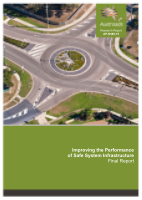Road Safety

- Publication no: AP-R498-15
- ISBN: 978-1-925294-83-5
- Published: 18 November 2015
- Edition: 1.1
- PDF (free) Download
This report summarises the findings of a three-year study which reviewed the safety performance of selected road infrastructure elements and provided solutions that were more closely aligned with the Safe System ideal.
The review examined the performance of signalised intersections, roundabouts and wire rope barriers. The solutions were developed following a literature review, statistical analysis of site data, in-depth crash data analysis, and expert guidance.
The review found that the safety performance of signalised intersections can be improved by managing high entry speeds and unfavourable impact angles using signalised roundabouts, and horizontal and vertical deflections on entry.
Roundabouts showing poor safety outcomes for cyclists and motorcyclists can be made safer by reducing approach and entry speeds. In these cases, tighter geometric design or additional supporting infrastructure can help reduced speeds.
Wire rope barriers were seen to deliver positive safety improvements relative to other roadside design options. Guidance refinement could further optimise safety outcomes.
Figure 4.1 was corrected and a revised edition provided in August 2019.
- Summary
- 1. Introduction
- 1.1. Purpose and Objectives
- 1.2. Scope
- 2. Methods
- 2.1. Literature Reviews
- 2.2. Crash Data Analysis
- 2.3. Severe Crash Site Analysis
- 2.3.1. Adopted Approach
- 2.3.2. Site Selection
- 2.3.3. Data Collection
- 2.3.4. Statistical Analysis (Probit Modelling)
- 2.4. In-depth Crash Analysis
- 2.5. Stakeholder and Expert Input
- 3. What Is Safe System Infrastructure?
- 3.1. Interpreting the Safe System Vision
- 3.2. Risk of Severe Injury and Road Infrastructure
- 3.3. Relevance to the Project Objective
- 4. Impact Speeds and Angles
- 4.1. Delta-v and Severe Injury Probability
- 4.2. Impact Speeds, Angles and Severe Injury Probability
- 5. Signalised Intersections
- 5.1. Safety Performance of Signalised Intersections in the Safe System Context
- 5.2. Severe Crash Factors
- 5.2.1. Opposing-turning Crashes
- 5.2.2. Adjacent Direction Crashes
- 5.2.3. Same Direction (Rear-end) Crashes
- 5.2.4. Pedestrian Crashes
- 5.3. Suggested Solutions
- 5.3.1. Low-speed Signalised Roundabout
- 5.3.2. High-speed Signalised Roundabout
- 5.3.3. Horizontal Deflections on Approaches
- 5.3.4. Vertical Deflections on Approaches
- 5.3.5. Grade Separation
- 5.3.6. Double Diamond Cross-over (DDC)
- 5.3.7. Red-light/Speed Cameras
- 5.3.8. Speed Limit Reductions
- 5.3.9. Improved Signal Visibility
- 5.3.10. Movement Control and Management
- 5.3.11. Discussion and Summary
- 6. Roundabouts
- 6.1. Safety Performance of Roundabouts in the Safe System Context
- 6.2. Severe Crash Factors
- 6.2.1. Adjacent Direction Crashes (Cyclists and Motorcyclists)
- 6.2.2. Off-path Crashes (Motorcyclists and Vehicles)
- 6.2.3. Same Direction Crashes (Cyclists)
- 6.3. Suggested Solutions
- 6.3.1. Horizontal Deflections on Approaches
- 6.3.2. Vertical Deflections on Approaches
- 6.3.3. Signalisation
- 6.3.4. Arterial Traffic Calming
- 6.3.5. Pavement Condition Improvement
- 6.3.6. Cyclist Bypass
- 6.3.7. Discussion and Summary
- 7. Wire Rope Barriers
- 7.1. Safety Performance of Wire Rope Barriers in the Safe System Context
- 7.2. Severe Crash Factors
- 7.3. Suggested Solutions
- 7.4. Discussion and Summary
- 8. Discussion Summary
- 9. Conclusion
- References
